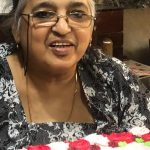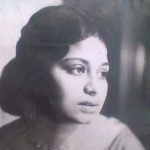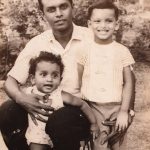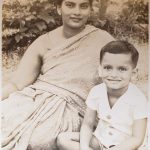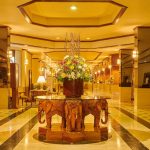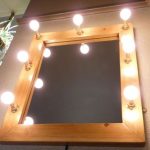GYPSY TALES : Chapter 06 – Old Kohuwala … on the way to the ‘Nursely’
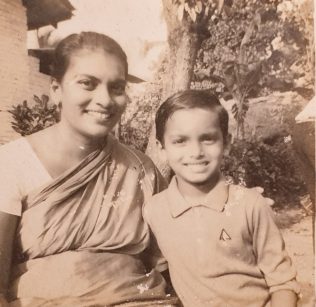
An integral part of Kohuwala’s history is the ‘Kalindu Bilindu Pasela’ and behind this landmark institution was an iconic figure – Bona de Lanerolle.
I was privileged to be one of her students from 1966-1967 before entering Wesley College the year after.
The ‘Nursely’ was located in her home ‘Green Lodge’ at No 20 on the road that ran from the Nugegoda junction across Kohuwala, past Kalubowila to the Galle Road in Dehiwala.
“At that time it was a miserable narrow road”, recalls Kalindi (de Lanerolle) Wirasingha, Bona’s daughter.
My earliest recollections of Bona, the grand lady, was the sound of her wooden clogs that announced her arrival which happened moments later.
Clippety-Clop. Clippety-Clop her wooden clogs would sound … and then seconds later Aunty Bona came around
But before all of that, my journey from home at No 25, Green Path to the Nursery was another experience in itself.
It was Granny who took me up and down. As we walked up Green Path, past all the low hedges, the neighbours would call out to me and ask me where I was going.
Good Heavens where could a brat of six or seven, all dressed up like that with a little satchel and a water bottle slung on his tender shoulders, be going to at that time of the morning other than a blessed Nursery ? Not to Office surely ?
But then that was standard neighbourly small talk. It was de rigueur and very much the norm and accepted too.
I would proudly and chirpily reply “I’m going to the Nursely.” Granny would growl and say “Come child come, we are getting late”. Clippety-Clop was known for her discipline and we dared not get late.
I was told that I was curious and inquisitive too. Curiosity may have killed the cat, but it hasn’t killed me … well not yet.
THE DHARA MADUWA
As we came to the top of Green Path, across the road, where the Laughs Super market now stands, was a ‘dhara maduwa’ (firewood seller).

I hope my memory has not failed me here. I never forgot to make Granny cross the road and slowly walk past it.
It was a glorious place full of big logs, small logs, and chopped sticks of firewood falling on top of each other across confetti-like sawdust strewn all over the earthen floor.
The smell of firewood was aromatic and delicious. Fully dried, half dried and sometimes even quite raw, and even moss and teeny weeny ferns still stuck on the logs. I loved that fragrance.
Dragging my feet on purpose, and conveniently a few steps behind Granny, I remember breathing in lungsful for those couple of minutes.
After a few months Granny got wind of this little private experience, literally behind her back, and admonishingly said “What nonsense is this child?. Are you mad? It’s bad for your lungs!”
She never crossed the road at that spot and there ended my olfactory tryst with the ‘dhara maduwa’.
VINCENT PERERA’S THAKSALA WEAVERS
Down at the Kohuwala Junction we turned right towards Nugegoda and walked towards the Nursery. This is where the magic began.
En route, on the same side of the road, was Vincent Perera’s ‘Thaksala Weavers’. The name meant nothing to me but what intrigued me was the coloured water that gushed out in a great hurry, out of random large concrete pipes into the main drain.
There were different colours on different days of the week. There were different colours in the morning on the way to ‘Nursely’ and then again different colours on the way back home from ‘Nursely’. I was intrigued. This was incomprehensible magic.
Sensing my inherent curiosity, Granny very seriously told me that families of fairies and gnomes and elves and pixies lived in that big building by the road. They came out only at night and played and played and played.
Since they dirtied their clothes a lot during the night, their poor parents had to wash all of them during the day. Hence the coloured water … different colours and different times. I believed it all …… for years.

RATHNA STORES
Down at the junction, at the bend when one turned towards Kalubowila was ‘Rathna Stores’.
This was where Daddy bought his cigars and Mummy all her groceries.
There were rice and flour and all kinds of pulses in large gunny bags standing upright on the floor, much like stocky sentinels.
THE ‘135’ BUS TO BORELLA
Beyond the junction, slightly uphill, on the left hand side was the 135 bus stop. This was the terminus, I was told. Buses started here and so we knew what times they left.
They were not in a maniacal hurry to gather passengers and then flee like lunatics to the next stop. The ride was peaceful.
In 1968 when I began schooling, this was my daily commute to Wesley College. Like a prayer, we boarded the 6.30 am bus. There weren’t hordes of passengers either.

Passengers knew each other and there was mutual respect that no one sat in the other’s customary seat. This being the start of the ride, one’s seat was always assured.
On occasional days when we were late to leave home, Mummy would quickly put my breakfast into a box and leisurely feed me as the CTB bus ambled all the way to Wesley College and then beyond to Kelaniya.
A part of that ride was when the bus stopped at the Wellawatte Spinning and Weaving Mills at ‘Redi Mola’ and the deer, a few of them, came to the wire mesh, almost daily, and shook their heads.
I foolishly believed they came to greet me. Daddy and Mummy very generously allowed me to believe so.
DISCLAIMER: All people, places and names in this chapter are drawn from the memory of a four/five year old child and so there might be errors. If any, they are purely erroneous and not intentional.
THANK YOU : To Kalindi (de Lanerolle) Wirasingha for connecting the dots in the vast swathes of my memory.
NEXT : Chapter 07 – And Bona Lanerolle went clippety-clop,






